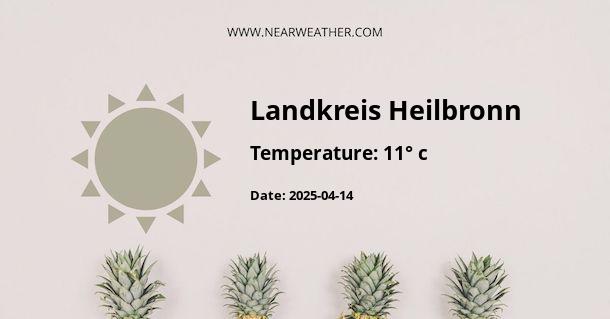Understanding the Climate and Weather Patterns of Landkreis Heilbronn, Germany
Landkreis Heilbronn, situated in the northern part of the state of Baden-Württemberg in Germany, experiences a temperate oceanic climate, which is influenced by the Atlantic Ocean. This climate is characterized by mild to warm summers, relatively mild winters, and precipitation that is distributed fairly throughout the year. To gain an in-depth understanding of the climate and weather year round in this region, a detailed exploration of seasonal climate patterns, temperature variations, and precipitation trends is essential.
Seasonal Climate Overview
The seasonal climate of Landkreis Heilbronn reflects typical European inland weather patterns, with four distinct seasons that bring their own weather conditions.
"With the changing of seasons, Landkreis Heilbronn showcases a rich tapestry of climatic variety, each month painting a unique picture of natural beauty and atmospheric diversity." — Regional Meteorological Authority.
- Spring: Spring in Landkreis Heilbronn typically begins in March and lasts until May. This season is often marked by an increase in temperatures and longer daylight hours.
- Summer: June through August is considered summer, where temperatures can range from comfortable to quite warm. This period often experiences the highest temperature readings of the year.
- Autumn: From September to November, the region witnesses autumn with cooler temperatures and falling leaves, signaling a transition to the winter period.
- Winter: Finally, winter sets in from December until February. The temperatures can drop to freezing points, and snow is common, particularly in January and February.
Temperature Analysis
Temperature in Landkreis Heilbronn fluctuates throughout the year, with typical highs and lows that frame the region's temperate climate.
| Month | Average High (°C) | Average Low (°C) |
|---|---|---|
| January | 3 | -2 |
| February | 4 | -1 |
| March | 9 | 1 |
| April | 14 | 4 |
| May | 18 | 8 |
| June | 22 | 12 |
| July | 24 | 14 |
| August | 24 | 13 |
| September | 19 | 10 |
| October | 14 | 6 |
| November | 7 | 2 |
| December | 4 | 0 |
Note: These are average temperature values and actual conditions may vary.
Precipitation Trends
Landkreis Heilbronn's precipitation does not significantly fluctuate seasonally due to oceanic influences, but certain months may experience slightly higher levels.
| Month | Average Precipitation (mm) |
|---|---|
| January | 45 |
| February | 40 |
| March | 50 |
| April | 50 |
| May | 60 |
| June | 70 |
| July | 80 |
| August | 70 |
| September | 60 |
| October | 50 |
| November | 50 |
| December | 50 |
This table reflects an average precipitation pattern, but it's important to note that extreme weather events can occasionally disrupt these averages.
Weather Influences and Extremes
While Landkreis Heilbronn's climate is relatively consistent, it can still be subject to weather extremes influenced by large-scale atmospheric patterns, such as the North Atlantic Oscillation. Extreme temperatures, both hot and cold, can occur, although they are relatively infrequent. Thunderstorms are also more common during summer months.
Climate Change Considerations
The impact of climate change is evident around the globe, and Landkreis Heilbronn is no exception. Recent years have shown trends toward warmer average temperatures and changes in precipitation patterns. Adaptation and resilience planning are crucial as these changes may affect agriculture, viticulture (a prominent industry in the region), and biodiversity within the local ecosystem.
Agricultural and Viticultural Implications
The climate of Landkreis Heilbronn is particularly conducive to agriculture and viticulture. The region's fertile soils and consistent weather patterns facilitate the growing of a diversity of crops, including the renowned local wine production. Climate conditions profoundly impact the quality and quantity of these agricultural yields. Mild winter and spring temperatures stimulate early plant growth, while warm summers enhance fruit ripening, essential for high-quality grape production.
Weather Forecasting and Climate Modeling
Weather forecasting and climate modeling for Landkreis Heilbronn rely on data collected from meteorological stations and satellite imagery. Through the use of these advanced technologies, meteorologists provide residents and visitors with accurate weather predictions, crucial for planning daily activities and for the agriculture sector to schedule planting and harvesting.
Conclusion
When analyzing the climate and weather patterns of Landkreis Heilbronn, Germany, one can appreciate the temperate conditions that define this region. Aided by sophisticated forecasting models, meteorologists can predict and analyze weather with precision, a vital aspect of life in this agriculturally rich land. With the future climate resilience in focus, Landkreis Heilbronn is poised to remain a vibrant district, rich in natural beauty and economic vitality.
A - Landkreis Heilbronn's Latitude is 49.200001 & Longitude is 9.200000.
A - Weather in Landkreis Heilbronn is 11° today.
A - Climate Conditions in Landkreis Heilbronn shows light rain today.
A - Humidity in Landkreis Heilbronn is 93% today.
A - Wind speed in Landkreis Heilbronn is 6.05 km/h, flowing at 149° wind direction. today.
